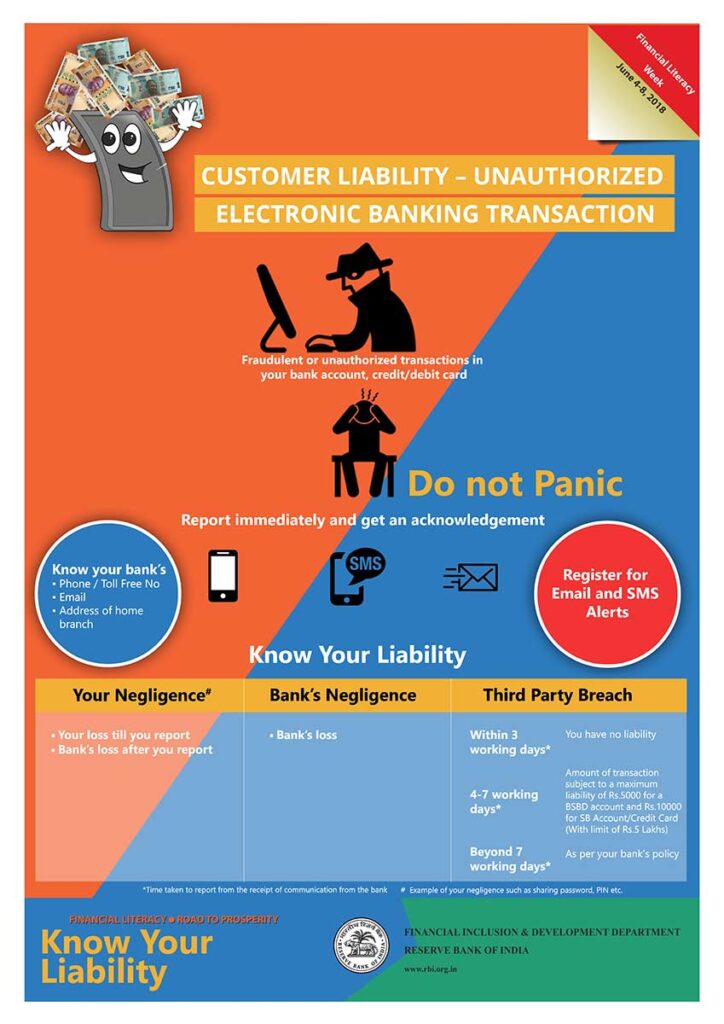Functions of the Reserve Bank of India (RBI)
Introduction:
The Reserve Bank of India (RBI) is the central banking institution in India, established in 1935. It plays a important role in the country’s financial system and is responsible for formulating and implementing monetary policies. The functions of the RBI are diverse, encompassing a wide range of activities that contribute to the stability and development of the Indian economy. Every bank is entitled to maintain a sum of money with the RBI which acts as a limit on the amount of money the bank can lend to the public. There are many other policies and regulations through which RBI keeps an eye on the country’s economy.
Monetary Policy Formulation of RBI:
1.Objective:
The primary objective of the Reserve Bank of India (RBI) in formulating its monetary policy is to achieve price stability within the economy. This involves keeping inflation within the target range set by the government, usually around 4% with a tolerance band of +/- 2%. Additionally, the RBI aims to support sustainable economic growth and maintain financial stability. Through its policy decisions, the RBI seeks to balance the goals of controlling inflation, promoting economic activity, ensuring adequate liquidity in the financial system, and promoting a stable environment for investment and job creation.

2.Tools:
(a) Repo Rate: This is the rate at which the RBI lends money to commercial banks for short periods. Changes in the repo rate influence borrowing and lending rates in the economy, affecting consumer spending, investment, and inflation.
(b) Reverse Repo Rate: This is the rate at which the RBI borrows money from commercial banks. Changes in the reverse repo rate impact liquidity in the banking system.
(c) Cash Reserve Ratio (CRR): Commercial banks are required to maintain a certain percentage of their deposits as reserves with the RBI. Adjustments to the CRR affect the liquidity available to banks for lending.
(d) Statutory Liquidity Ratio (SLR): Banks are also required to maintain a certain percentage of their deposits in specified liquid assets like government securities. Changes in SLR impact banks’ ability to lend.
Currency Issuance and Management:
1. Currency Production: RBI oversees the printing of bank notes and minting of coins. It cooperates with specialized printing presses and mints to ensure the quality and security of currency production. Currency production involves the use of sophisticated printing techniques, security features and materials to prevent counterfeiting and ensure durability.

2. Currency distribution: After production, the currency is distributed across various channels including commercial banks, financial institutions and depository of the RBI located across the country. Depository of the RBI are managed by commercial banks on behalf of the RBI and serve as storage facilities for physical currency. They ensure the availability of cash to meet the demand of banks, businesses and the public.
3. Currency Regulation: RBI regulates the circulation of currency through various measures, including laying down guidelines for return and re-issue of damaged or soiled bank notes, monitoring currency circulation patterns and fight against counterfeit currency. Regulation also involves ensuring the adequacy of the money supply to meet the demand for cash transactions in various sectors and sectors of the economy.
4. Currency Withdrawal: As part of currency management, the RBI periodically withdraws old or damaged bank notes from circulation to maintain the integrity and utility of the currency. Bank notes withdrawn through the process of demonetization or phased currency exchange programs are generally replaced with new notes.
5. Cash management: Cash management involves optimizing the distribution and circulation of currency to ensure efficient cash flow within the economy. RBI employs various tools and strategies such as cash forecasting, currency rationing and cash logistics to manage the money supply and minimize disruptions in cash availability.
6. Currency Authentication and Security: RBI imposes strict measures to authenticate and secure bank notes and coins to prevent counterfeiting and fraud. The currency has advanced security features like watermarking, security threads, holograms and special inks that are difficult to replicate.
7. Currency Research and Development: RBI conducts research and development activities to enhance the security, stability and accessibility of currency. This may include exploration of new technologies, materials and designs to improve the quality of bank notes and coins.
8. Public Awareness and Education: RBI educates the public about currency-related matters, including security features, proper operation and detection of counterfeit currency. Public awareness campaigns aim to promote confidence in the currency and reduce the circulation of counterfeit notes.

Regulation and Supervision of Banking System:
1. Licensing and Regulation: RBI is responsible for issuing licenses to banks to operate in India. It sets out the eligibility criteria and guidelines for obtaining a banking license. It also regulates the entry of foreign banks into the Indian market and sets norms for their operations.
2. Prudential norms: RBI establishes prudential norms and guidelines that banks must follow in their functioning. These norms cover aspects such as capital adequacy, asset classification, provisioning requirements, risk parameters and risk management practices. Its objective is to ensure that banks maintain healthy financial positions and manage risks effectively.
3. Supervision and Inspection: RBI carries out regular supervision and inspections to assess the financial health, compliance with regulations and risk management practices of banks. It employs a risk-based supervision framework, where higher risk banks are subject to more frequent and intensive supervision.
4. On-site Inspection: RBI conducts on-site inspections to check the books, accounts and operations of banks. It verifies compliance with regulatory requirements, assesses asset quality, evaluates risk management systems, and identifies any potential weaknesses or vulnerabilities.
5. Off-site monitoring: Apart from on-site inspection, RBI also carries out off-site monitoring of banks through analysis of their financial statements, regulatory reports and other relevant data. This helps in early detection of emerging risks and trends in the banking system.
6. Prompt Corrective Action (PCA): RBI has the authority to initiate prompt corrective action against banks that show signs of financial distress or are not in compliance with regulatory requirements. The PCA framework imposes restrictions on certain activities of such banks and is aimed at preventing their financial health from deteriorating further.
7. Regulatory reporting: Banks are required to submit periodic reports and returns to the RBI, providing information on various aspects of their operations, financial position and risk exposures. This enables RBI to monitor their performance and take necessary regulatory action as and when required.
8. Resolution of weak banks: In the event of a bank facing financial difficulties or failure, it is the responsibility of the RBI to intervene and initiate resolution measures. It may facilitate mergers or acquisitions, arrange capital investments, or take other measures to protect the interests of depositors and maintain stability in the banking system.
9. Consumer Protection: RBI also focuses on consumer protection and ensures that banks comply with fair practices and transparent disclosure norms. It handles complaints from bank customers and takes appropriate action against banks found guilty of malpractices or misconduct.

Banker to the Government:
1. Custodian of Government Accounts: As the government’s banker, the central bank maintains and manages various accounts of the government. It includes the Consolidated Fund of India, Contingency Fund of India and Public Account of India. These funds include the revenue, expenditure and other financial transactions of the government.
2. Receipt and Payment Services: The central bank assist the receipt and payment of money on behalf of the government. It accepts government revenues, such as taxes and income from debt issuance, and processes government payments, including salaries, pensions, and debt service.
3. Management of public debt: The central bank manages the issuance, repayment, and redemption of government debt, including treasury bills, government bonds, and other securities. It conducts auctions of government securities and acts as a market maker to ensure liquidity in the government bond market.
4. Cash Management: The central bank helps the government in managing cash flows and liquidity needs. It provides overdraft facilities and short-term financing to the government to meet temporary mismatches between receipts and expenditure.
5. Advisory role: The central bank advises the government on matters related to fiscal policy, public debt management and cash flow forecasting. It provides awareness into the macroeconomic implications of government policies and helps in formulating strategies to maintain fiscal discipline and financial stability.
6. Monetary policy coordination: As the central bank, it coordinates monetary policy with fiscal policy objectives. Close cooperation between the central bank and the government is essential to ensure that monetary and fiscal policies are aligned to achieve macroeconomic stability and sustainable economic growth.
7. Regulatory supervision: While acting as the government’s banker, the central bank also maintains its regulatory and supervisory role over the banking system. It ensures that banks comply with regulations relating to government transactions, public debt holdings and prudential norms.
8. Privacy and Security: The central bank ensures the privacy and security of government transactions and information. It employs robust systems and procedures to protect government funds and sensitive data from unauthorized access or misuse.
Foreign Exchange Management:
1. Regulatory framework: Governments usually establish rules and policies to regulate foreign exchange transactions. These rules may be set by central banks, monetary authorities or other regulatory bodies. The regulatory framework aims to maintain stability in the foreign exchange market, prevent currency manipulation, and protect the economic interests of the country.
2. Exchange Rate Regimes: Countries adopt various exchange rate regimes to determine the value of their currencies relative to other currencies. Common exchange rate arrangements include fixed exchange rates, floating exchange rates, and managed float systems. The choice of exchange rate regime affects the conduct of foreign exchange management policies.
3. Foreign exchange reserves: Central banks maintain foreign exchange reserves to intervene in the foreign exchange market and stabilize the value of the domestic currency. These reserves typically include foreign currencies, gold and other assets. Central banks use foreign exchange reserves to manage exchange rate volatility, support the domestic currency, and meet external payment obligations.
4. Exchange Controls: Some countries impose exchange controls to regulate the flow of foreign currency and prevent capital flight. Exchange controls may include restrictions on currency conversion, limits on foreign currency transactions, and approval requirements for certain types of transactions. These controls are often used to manage the balance of payments and maintain monetary stability.
5. Foreign Exchange Market: Foreign exchange markets are where currencies are bought and sold. These markets operate 24 hours a day, five days a week, and are decentralized, with trading conducted electronically through a network of banks, financial institutions, and brokers. Central banks and monetary authorities may intervene in the foreign exchange market to influence exchange rates or correct imbalances.
6. Foreign Exchange Transactions: Foreign exchange transactions involve the exchange of one currency for another at an agreed exchange rate. These transactions include trade-related transactions (importing and exporting goods and services), capital flows (investing and borrowing), and speculative activities (currency trading for profit). The goal of foreign exchange management is to facilitate these transactions while minimizing risks and ensuring compliance with regulations.
7. Surveillance and monitoring: Regulatory authorities monitor foreign exchange markets and transactions to detect and prevent illegal activities such as money laundering, terrorist financing and currency manipulation. They can use monitoring tools, such as transaction monitoring systems, reporting requirements and cooperation with international agencies, to increase oversight and enforcement.
8. Policy Coordination: Foreign exchange management requires coordination between monetary policy, fiscal policy and other economic policies. The central bank, the finance ministry, and other relevant authorities cooperate to formulate and implement policies that promote exchange rate stability, facilitate international trade and investment, and support overall economic objectives.




